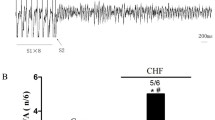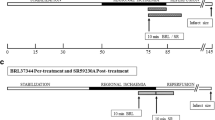Abstract
To determine whether prior acute Beta blockade protects the heart against the deleterious effects of normothermic low flow global ischemia on myocardial function, aortic pressure, developed pressure, dP/dtmax and end diastolic pressure were monitored in isolated perfused rabbit hearts prior to, during and following 30 and 60 min ischemia, during which either Krebs-Henseleit (control) or Beta blocking agents, Bevantolol (cardioselective) or Propranolol (non-selective) were perfused through the heart. Control hearts made ischemic for 30 min and then reperfused had significantly elevated end diastolic (p < .01) and aortic pressures (p < .01) and reduced developed pressure relative to baseline (p < .05). Hearts treated with Bevantolol or Propranolol (3 × 10-5 m/l) 5 min prior to and during 30 min ischemia recovered preischemic developed pressure and dP/dtmax (p > 0.05), while end diastolic pressure was elevated (p < .01, p < .05 respectively). Aortic pressure was unchanged relative to baseline (p > .05). Comparison of indices from hearts under Beta blockade with controls showed that following 30 min ischemia and recovery, the Bevantolol treated group had reduced aortic pressure (p < .01) and end diastolic pressure (p < .05) and increased percent developed pressure and percent dP/dtmax (p < .001) relative to control. In the propranolol treated group, end diastolic pressure was reduced and percent developed pressure (p < .01) and percent dP/dtmax (p < .001) were increased relative to unblocked hearts. Following 60 min ischemia and 30 min reperfusion, reduction in all functional indices occurred, however dP/dtmax was unchanged from baseline in the Propranolol and Bevantolol treated groups. Comparison between groups showed that the Bevantolol treated group had significantly better dP/dtmax and developed pressure (p < .05), whereas the Propranolol group shows no significant difference from baseline (p > .05) (K-H). We conclude that following short periods of ischemia, Beta blockade protects the heart from deleterious function effects of ischemia but that the protective effect is diminished in Bevantolol relative to Propranolol treatments following prolonged ischemia. The data indicates that the beneficial effects of Beta blockade in reducing ischemic induced damage occurs early during conditions of ischemia such as would be present in the setting of acute myocardial infarction.
Similar content being viewed by others
References
Nayler WG, Ferrari R, Williams A: Protective effect of pretreatment with Verapamil, Nifedipine and Propranolol on mitochondrial function in the ischemic and reperfused myocardium. Am J Cardiol 46: 242–248, 1980
Buck JD, Gross GJ, Wartier DC, Jolly SR, Hardman HF: Comparative effects of cardioselective versus noncardioselective beta blockade on subendocardial blood flow and contractile function in ischemic myocardium. Am J Cardiol 20: 265–268, 1979
Hartog JM, Verdouin PD: Alleviation of myocardial ischemia after administration of the cardioselective beta adrenoreceptor antagonist Bevantolol. Cardiovasc Res 20: 265–268, 1986
Wartier DC, Gross GJ, Jesmok GJ, Brooks HL, Hardman HF: Protection of ischemic myocardium: comparison of effects of Propranolol, Bevantolol and N-Dimethyl Propranolol on infarct size following coronary artery occlusion in anesthetized dogs. Cardiology 66: 133–146, 1980
Verdouw PD, Van Bremen RH, Verkeste CM, Van Der Giessen WJ: Antiarrhythmic action and protection of ischemic myocardium after beta blockade with Bevantolol. Eur J of Pharmacol 11: 377–380, 1985
Berdeaux A, Boissier JR, Guidicelli JF: Effects of Atenolol on regional myocardial blood flow and ST-segment elevation in the canine myocardium. Br J Pharmacol 60: 433–439, 1977
Marshal RL, Parratt JR: Comparative effects of Propranolol and Practolol in the early stages of experimental canine myocardial infarction. Br J Pharmacol 57: 295–303, 1976
Vatner SF, Baig H, Manders WT, Och H, Pagani M: Effects of Propranolol on regional myocardial function, electrograms, and blood flow in conscious dogs with myocardial ischemia. J Clin Invest 60: 353–360, 1977
Gross GJ, Winbury MM: Beta adrenergic blockade on intramyocardial distribution of coronary blood flow. J Pharmacol Exp Ther 187: 451–464, 1973
Hastings SG, Smith RD, Corey RM, et al: Pharmacologic evaluation of C1-775, a cardioselective beta adrenergic antagonist. Arch Int Pharmacodyn 226: 81–99, 1977
Wartier DC, Gross GJ, Jesmok GJ, Brooks HL, Hardman HF: Protection of ischemic myocardium: comparison effects of Propranolol, Bevantolol and N-Dimethyl Propranolol on infarct size following coronary artery occlusion in anesthetized dogs. Cardiology 66: 133–146, 1980
Becker LC, Fortuin NJ, Pitt B: Effect of ischemia and antianginal drugs on the distribution of radioactive micro spheres in the canine left ventricle. Circ Res 28: 263–269, 1971
Tomlinson CW, Toleikis PM: Myocardial protection during ischemia in the isolated perfused rabbit heart. Can J Cardiol 136–143, 1987
Henry PO, Shuchleib R, Davis J, Weiss ES, Sobel BF: Myocardial contracture and accumulation of mitochondrial calcium in the ischemic rabbit heart. Am J Physiol 223: H677–684, 1977
Shen AC, Jennings RB: Kinetics of calcium accumulation in acute myocardial ischemic injury. Am J Physiol 67: 441–452, 1972
Nayler WG, Elz JS: Reperfusion injury: laboratory artifact or clinical dilemma? Circulation 74: 215–221, 1986
Gross GJ, Buck JD, Wartier DC, Hardman AF: Beneficial actions of Bevantolol on subendocardial blood flow and contractile function in ischemic myocardium. J Card Pharmacol 1: 139–147, 1979
Author information
Authors and Affiliations
Rights and permissions
About this article
Cite this article
Toleikis, P.M., Tomlinson, C.W. Myocardial functional preservation during ischemia: Influence of beta blocking agents. Mol Cell Biochem 176, 205–210 (1997). https://doi.org/10.1023/A:1006884625215
Issue Date:
DOI: https://doi.org/10.1023/A:1006884625215




